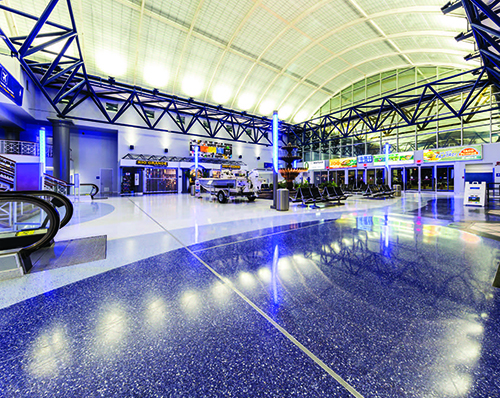Airports Use Decorative Flooring to Create Sense of Place


When Pensacola International (PNS) and Valley International (VIA) replaced flooring in their respective facilities, the two airports selected different materials; but both chose colors and patterns that portray their local Gulf Coast water and landscapes.
PNS, located in the panhandle of Florida, installed a combination of porcelain tile and carpet. Across the gulf, at the southeastern tip of Texas, VIA replaced its old pink and gray ceramic tile with new blue and white terrazzo.
“This project was all about the customer experience,” explains PNS Director Dan Flynn. “We wanted something very appealing and aesthetically pleasing. The lighter tile makes the terminal look so much brighter, and overall the tile and carpet create a comfortable and attractive atmosphere.”
|
facts&figures
Location: Pensacola (FL) Int’l Airport Project Duration: Jan. 23, 2019 – June 7, 2019 Cost: $566,000 Scope: 14,000 sq. ft. of tile; 7,000 sq. ft. of carpet Primary Contractor/Designer: Mott MacDonald Carpet Manufacturer: Interface Porcelain Tile Manufacturer: Crossville Inc. Tile & Carpet Installation: Carpet Creations Inc. Of Note: All old carpeting was recycled; no material sent to landfill
Location: Valley Int’l Airport— Harlingen, TX Project Duration: Sept. 2018 – Feb. 2019 Cost: $1.2 million Square Footage: 32,000 sq. ft. General Contractor: SpawGlass Architect: Megamorphosis, Inc. Installer: Mion Tile & Terrazzo Of Note: Contractor installed a moisture barrier over slab; new terrazzo is costing much less to maintain than airport’s 1980s ceramic tile |
The airport turned to design consultants from Mott MacDonald to help select a durable, long-lasting alternative to replace the carpet along the center concourse. The carpet that was removed was from a project that ended in 2011. “Carpet typically has a usage of about seven to eight years, so it was time to replace it,” notes Flynn.
After considering a variety of materials, the team selected porcelain tile for the concourse hallways and carpeting for the holdrooms. While PNS management and staff like the terrazzo flooring in the ticketing area, terrazzo would not have been practical to install in the 400-foot-long, 35-foot-wide concourse.
“Terrazzo requires a very long installation process, and large areas would have needed to be blocked off, interfering with operations and passenger travel,” explains Anne Brooks, Mott MacDonald’s lead interior designer for the project. “We had to identify a material that could be worked on overnight and did not interfere with passenger traffic. We chose porcelain for its durability, ease of maintenance and the fact that it is similar to terrazzo.”
Acoustics were also important to the airport, so designers chose a large tile with small grout joints to reduce noise from rolling luggage and carts. Since the porcelain was untested in the concourse area, the design and installation teams conducted a roller board test on the first area of tile installed.
“We were pleasantly surprised,” says Brooks. “The roller boards were not any louder on porcelain than they were on terrazzo.”
Carpet was installed in the boarding areas to absorb noise and create a comfortable space for departing passengers. Its custom color is designed to hide soiling, and the plank-style installation allows the airport maintenance team to remove, replace and clean individual pieces.
All of the previous carpeting that was removed was pelletized and will be recycled into new carpet. “The fibers and backing are melted down, and new yarn and backing materials are created to refabricate carpet tile,” explains Brooks. “Not one carpet tile taken up from the terminal will end up in a landfill as a non-biodegradable item.”
Pressing Need

Valley International Airport (VIA), in Harlingen, TX, replaced pink and gray ceramic tile flooring that had been installed in the late 1980s. In some areas, the bond to the subfloor had failed, causing tiles to lift and crack. For years, the airport had dutifully replaced tiles, but its stock of replacement tiles eventually depleted and the same product was no longer available.
“It was falling apart and becoming a trip hazard to our passengers,” notes Bryan Wren, VIA’s assistant aviation director. “It was also a porous, heavily textured tile, and years and years of dirt and wax had built up inside it. It was impossible to maintain or clean.”
The airport contracted the architectural firm Megamorphosis to help it select a new material. “We were in need of an easy-to-maintain flooring that was modern and would look great for decades,” explains Wren.

Terrazzo again emerged as the material of choice. “Terrazzo is a seamless solution without grout joints that makes it easier to maintain than many other tiles,” explains Doug Junkin, a project manager with Megamorphosis. “The seamless floor also makes it easier for rolling luggage, provides improved accessibility and reduces noise levels from rolling luggage and carts,”
Before installing the new terrazzo, the project team conducted a moisture test. Because the test indicated high levels of moisture in the concrete slab, crews installed a moisture mitigation layer to prevent cracking and lifting in the new terrazzo.
The new terrazzo flooring cost $1.2 million, and is the final and most visible component in a renovation and modernization project that cost $12 million.

The flooring has not only given the terminal a new modern look, but it is also proving easier to maintain and clean. Wren reports cleaning the new terrazzo costs a fraction of what VIA used to pay to fix/repair its old tile.
Creating a Sense of Place
Like many airports, PNS and VIA wanted their new flooring to help create a sense of place for the thousands of customers who travel through their terminals each day.
At PNS, the project team was tasked with reflecting the city of Pensacola’s brand: “Welcome to the Beach.” When selecting tile for the concourse, the team took its cues from the terrazzo installed on the ticketing and baggage claim level, which features a marine life design.

“Since the concourse is above the ticketing level, we went with a design of the birds that literally fly over the beach,” explains Brooks. “Pensacola is known as pelican city, so the porcelain tile features birds that are taking off and landing, bringing to mind airport travel.”
 The team chose a palette of light grays and beige to bring to mind sandy beaches. Gentle waves etched in the tile encourage movement along the concourse. The carpeting has blue and green hues to complement the city’s branding.
The team chose a palette of light grays and beige to bring to mind sandy beaches. Gentle waves etched in the tile encourage movement along the concourse. The carpeting has blue and green hues to complement the city’s branding.
The team selecting new terrazzo for VIA also took design cues from the natural environment.
“The main influence was our region—mainly the beach, Laguna Madre, Gulf of Mexico and the Rio Grande River,” explains Junkin. “The design can be interpreted a few ways: as sandbars with water on either side, as a meandering river, or as the beach at the Gulf of Mexico. The design was also meant to help guide passengers through the airport, from ticketing to the main lobby to baggage claim.”

FREE Whitepaper
PAVIX: Proven Winner for All Airport Concrete Infrastructure
International Chem-Crete Corporation (ICC) manufactures and sells PAVIX, a unique line of crystalline waterproofing products that penetrate into the surface of cured concrete to fill and seal pores and capillary voids, creating a long lasting protective zone within the concrete substrate.
Once concrete is treated, water is prevented from penetrating through this protective zone and causing associated damage, such as freeze-thaw cracking, reinforcing steel corrosion, chloride ion penetration, and ASR related cracking.
This white paper discusses how the PAVIX CCC100 technology works and its applications.
 Project: Installing New Tile & Carpet
Project: Installing New Tile & Carpet
 Project: Terrazzo Installation
Project: Terrazzo Installation








